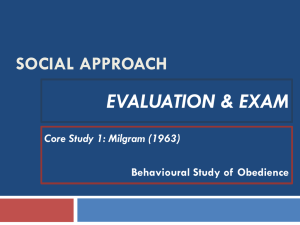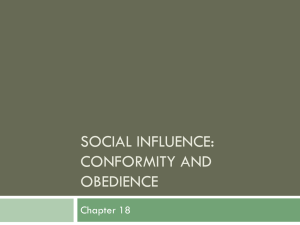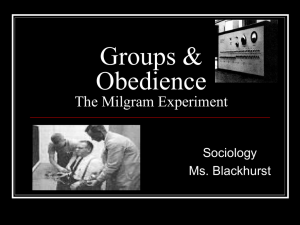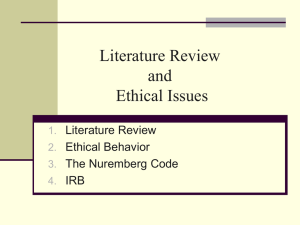Milgram and Bocchiaro
advertisement
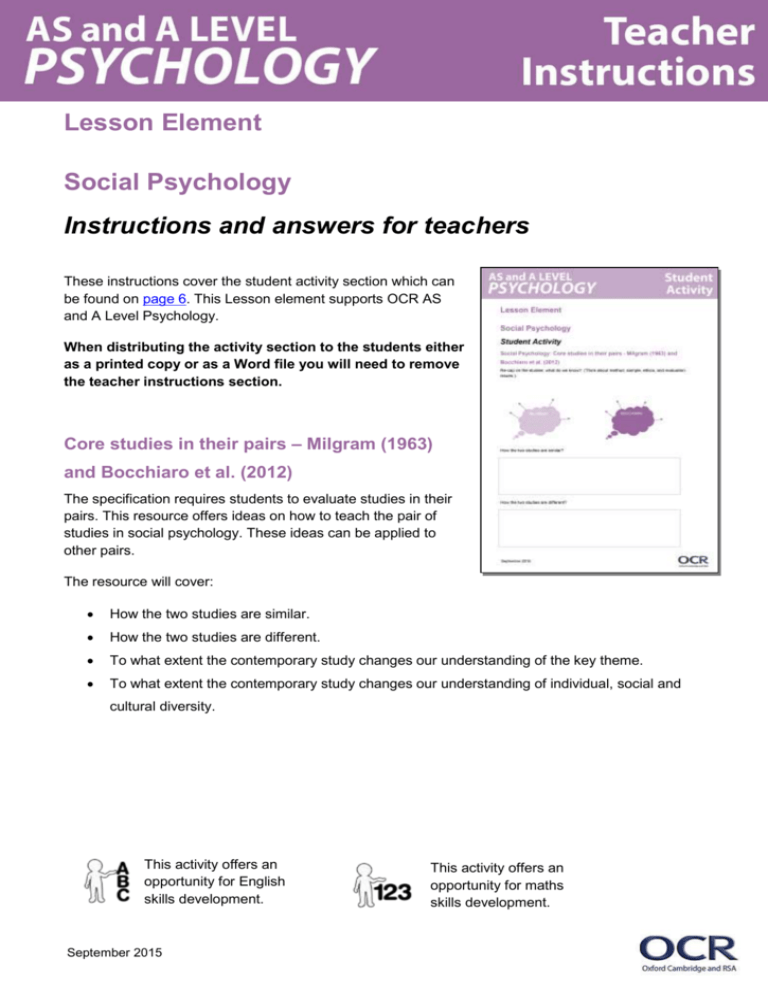
Lesson Element Social Psychology Instructions and answers for teachers These instructions cover the student activity section which can be found on page 6. This Lesson element supports OCR AS and A Level Psychology. When distributing the activity section to the students either as a printed copy or as a Word file you will need to remove the teacher instructions section. Core studies in their pairs – Milgram (1963) and Bocchiaro et al. (2012) The specification requires students to evaluate studies in their pairs. This resource offers ideas on how to teach the pair of studies in social psychology. These ideas can be applied to other pairs. The resource will cover: How the two studies are similar. How the two studies are different. To what extent the contemporary study changes our understanding of the key theme. To what extent the contemporary study changes our understanding of individual, social and cultural diversity. This activity offers an opportunity for English skills development. September 2015 This activity offers an opportunity for maths skills development. Firstly, get students to re-cap on the studies: what do we know? (Think about method, sample, ethics, and evaluation issues.) MILGRAM BOCCHIARO Students will then need to try to complete the tables on their resources - here are the completed versions Similarities Examples from the studies Both Milgram and Bocchiaro conducted research in a lab. Milgram and Bocchiaro’s studies were both conducted under controlled conditions, and so could eliminate extraneous variables. On the other hand, it also means that both studies lack ecological validity – therefore, we cannot generalise the findings to real life. Both studies investigate social psychology, specifically obedience to orders that goes against a moral code. E.g. Milgram studied obedience to authority in an attempt to understand the Holocaust, and Bocchiaro studied obedience/ disobedience in everyday life. Participants in both studies were paid to participate. Participants in Milgram’s study were paid $4.50 to take part. Participants in Bocchiaro’s study were paid seven euros or given credits for their university course. Both studies involved ‘deception.’ Participants in Milgram’s study were told that the study was concerned with the effect of punishment on learning, and Bocchiaro’s participants were deceived by being told that the research was concerned with sensory deprivation. Both studies show that people tend to be very obedient. 76.5% of participants obeyed in Bocchiaro’s study, and 65% obeyed to 450v in Milgram’s study. Both studies lack external validity and are ethnocentric. Both studies relied on a self-selecting sample, for example Milgram advertised in a newspaper and Bocchiaro advertised in a student cafeteria. Milgram used only males, and Bocchiaro used only students, therefore neither study can generalise beyond the sample, causing a lack of external validity. Both studies have practical applications and are therefore useful. Both enable us to predict and tackle the tendency to obey orders that directly/ indirectly lead to harm and suffering in others. E.g. Milgram can be used to predict atrocities and is used for this by the International Criminal Court; Bocchiaro’s is more relevant to understanding everyday injustice in the work place- in particular the low rates of whistle blowing. September 2015 Differences Examples from the studies Milgram used an all-male sample, whereas, Bocchiaro et al used a student sample of males and females. Milgram used 40 males from the New Haven area of America, whereas Bocchiaro et al used 96 women and 53 men within their sample of participants. Bocchiaro’s sample was much larger than Milgram’s sample. 149 Bocchiaro et al vs 40 Milgram. Milgram and Bocchiaro investigated obedience in different contexts Milgram’s study involved direct orders to commit an act of physical violence to understand the Holocaust, whereas Bocchiaro et al. were more concerned with everyday situations. Bocchiaro’s study was more ethical than Milgram’s study. In Milgram’s study participants experienced physical and psychological distress- the right to withdraw was also limited by the experimenters prods. For example, the experimenter prods in Milgram’s’ study reduced the right to withdraw, and participants had actual seizures as a result of the psychological stress caused by believing they were administering electric shocks; participants in Bocchiaro et al’s study were directed to write a message, which was much less distressing, and no physical harm was caused. Milgram collected both qualitative data, whereas Bocchiaro et al only collected quantitative data. Milgram recorded the behaviour and comments of the participants, in addition to the number of participants who shocked to each level; in contrast Bocchiaro et al collected only numerical data, by recording the number of people writing the message to persuade other students to take part in sensory deprivation- they measured the frequency of whistle blowing. Each of the studies had a different focus within the area of obedience. Bocchiaro’s study focused on whistle blowing, disobedience as well as obedience, whilst also investigating the role of dispositional factors, whereas Milgram’s study focused solely on destructive obedience. Bocchiaro conducted pilot studies, whereas Milgram did not. Bocchiaro conducted eight pilot studies with 92 participants to ensure that the procedure was credible and ethically acceptable; this is a stark contrast to Milgram, who did not conduct any pilot studies, and did not anticipate the level of obedience, or the ethical implications of his study. Bocchiaro studied the role of dispositional factors in obedience whereas Milgram investigated the situational hypothesis. Bocchiaro investigated whether six personality traits were assessed with levels of obedience, disobedience or whistle blowing, whereas Milgram focused on the situation that participants were placed in i.e. run down office/ Yale University. September 2015 Students must then try to complete two sample exam questions, in the PEE tables. Examples of the level of detail is below. Students can choose any comparison point, but they must add detail and examples in order to achieve the marks. Questions: 1. Outline one difference between Milgram’s study of obedience and Bocchiaro et al’s study of disobedience and whistle blowing. (Advise students to use PEE.) Point: One difference is that Milgram’s study was more unethical than Bocchiaro et al’s study. Explain: In Milgram’s study participants experienced physical and psychological distress- the right to withdraw was also limited by the experimenters prods. This is in contrast to Bocchiaro et al’s study in which participants did not experience physical harm, and also had the right to withdraw. Example: For example, the experimenter prods in Milgram’s’ study reduced the right to withdraw, and participants had actual seizures as a result of the psychological stress caused by believing they were administering electric shocks; participants in Bocchiaro et al’s study were directed to write a message, therefore much less distressing, and no physical harm caused. 2. Outline one similarity between Milgram’s study of obedience and Bocchiaro et al’s study of disobedience and whistle blowing. (Advise students to use PEE.) Point: One similarity is that Milgram and Bocchiaro et al both conducted laboratory experiments. Explain: Both studies had high control over extraneous variables, and highly standardised procedures leading to high levels of internal reliability and validity. It also means that both studies lack ecological validity. Example: for example Milgram’s research took place in a room at Yale University, therefore an artificial situation, the role of the experimenter was scripted, and therefore highly standardised. Similarly Bocchiaro et al’s study took place in a room at the VU University, the instructions given to each participants were standardised (given in the same way,) therefore highly controlled. To what extent does the contemporary study (Bocchiaro) change our understanding of the key theme? Bocchiaro has demonstrated that people in everyday situations, are very likely to be obedient. This finding supports previous research by Milgram, who also concluded that people are obedient to authority figures. In this sense, there has been no major change in our understanding of obedience to authority. September 2015 To what extent does the contemporary study (Bocchiaro) change our understanding of individual, social and cultural diversity? Additionally, Bocchiaro has supported Milgram’s situational hypothesis, by concluding that there is little/no evidence to suggest that dispositional factors affect obedience/ whistleblowing. This therefore supports Milgram’s idea of the ‘banality of evil.’ Despite individual beliefs/ moral codes, in particular situations, people will obey, even if it means that others will come to harm whether that be physical, or that they endure/ suffer the results of bad practice. We’d like to know your view on the resources we produce. By clicking on ‘Like’ or ‘Dislike’ you can help us to ensure that our resources work for you. When the email template pops up please add additional comments if you wish and then just click ‘Send’. Thank you. If you do not currently offer this OCR qualification but would like to do so, please complete the Expression of Interest Form which can be found here: www.ocr.org.uk/expression-of-interest OCR Resources: the small print OCR’s resources are provided to support the teaching of OCR specifications, but in no way constitute an endorsed teaching method that is required by the Board, and the decision to use them lies with the individual teacher. Whilst every effort is made to ensure the accuracy of the content, OCR cannot be held responsible for any errors or omissions within these resources. © OCR 2015 - This resource may be freely copied and distributed, as long as the OCR logo and this message remain intact and OCR is acknowledged as the originator of this work. OCR acknowledges the use of the following content: Maths and English icons: Air0ne/Shutterstock.com Please get in touch if you want to discuss the accessibility of resources we offer to support delivery of our qualifications: resources.feedback@ocr.org.uk September 2015 Lesson Element Social Psychology Student Activity Core studies in their pairs - Milgram (1963) and Bocchiaro et al. (2012) Re-cap on the studies: what do we know? (Think about method, sample, ethics, and evaluation issues). MILGRAM How the two studies are similar? How the two studies are different? September 2015 BOCCHIARO Using the information you have on the two studies, complete the tables below. Similarities Examples from the studies Milgram and Bocchiaro’s studies were both conducted under controlled conditions, and so could eliminate extraneous variables. One the other hand, it also means that both studies lack ecological validity - cannot generalise the findings to real life. Both studies investigate social psychology, specifically obedience to orders that goes against a moral code. E.g. Milgram studied obedience to authority in an attempt to understand the Holocaust, and Bocchiaro studied obedience/ disobedience in everyday life. Participants in both studies were paid to participate. Both studies involved ‘deception.’ Both studies show that people tend to be very obedient. Both studies lack external validity and are ethnocentric. Both studies rely on self-selecting sample, for example Milgram advertised in a newspaper, and Bocchiaro advertised in a student cafeteria. Milgram used only males, and Bocchiaro used only students, therefore neither study can generalise beyond the sample, causing a lack of external validity. Both enable us to predict and tackle the tendency to obey orders that directly/ indirectly lead to harm and suffering in others. E.g. Milgram can be used to predict atrocities and is used for this by the International Criminal Court; Bocchiaro’s is more relevant to understanding everyday injustice in the work place- in particular the low rates of whistle blowing. September 2015 Differences Examples from the studies Milgram used an all-male sample, whereas, Bocchiaro et al used a student sample of males and females. Bocchiaro’s sample was much larger than Milgram’s sample. Milgram and Bocchiaro investigated obedience in different contexts Milgram’s study involved direct orders to commit an act of physical violence to understand the Holocaust, whereas Bocchiaro et al. were more concerned with everyday situations. Bocchiaro’s study was more ethical than Milgram’s study. Milgram recorded the behaviour and comments of the participants, in addition to the number of participants who shocked to each level; in contrast Bocchiaro et al collected only numerical data, by recording the number of people writing the message to persuade other students to take part in sensory deprivation- they measured the frequency of whistle blowing. Each of the studies had a different focus within the area of obedience. Bocchiaro conducted eight pilot studies with 92 participants to ensure that the procedure was credible and ethically acceptable; this is a stark contrast to Milgram, who did not conduct any pilot studies, and did not anticipate the level of obedience, or the ethical implications of his study. Bocchiaro studied the role of dispositional factors in obedience whereas Milgram investigated the situational hypothesis. September 2015 Questions: 3. Outline one difference between Milgram’s study of obedience and Bocchiaro et al’s study of disobedience and whistle blowing. Point Explain (how is it different?) Example (specific examples from both studies) A difference is that…. 4. Outline one similarity between Milgram’s study of obedience and Bocchiaro et al’s study of disobedience and whistle blowing. Point A similarity is that…. September 2015 Explain (how is it different?) Example (specific examples from both studies) To what extent does the contemporary study changes our understanding of the key theme. To what extent the contemporary study changes our understanding of individual, social and cultural diversity? To what extent does the contemporary study (Bocchiaro) change our understanding of the key theme? To what extent does the contemporary study (Bocchiaro) change our understanding of individual, social and cultural diversity? September 2015
